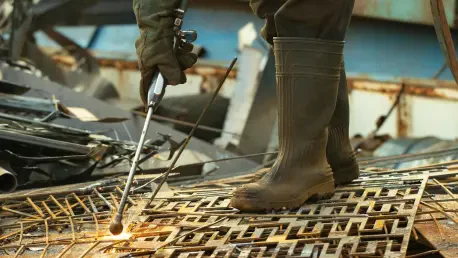In a groundbreaking leap toward sustainable industrial practices, a Swiss company has unveiled an innovation that could redefine steel recycling for high-end manufacturing sectors, based in the historic watchmaking hub of La Chaux-de-Fonds. This pioneering technology harnesses the power of the sun to melt steel waste, offering a cleaner, greener alternative to traditional methods. With industries like watchmaking and medical manufacturing generating significant amounts of high-quality steel offcuts, the need for environmentally friendly recycling solutions has never been more pressing. This development not only addresses carbon emissions but also champions a circular economy by transforming scraps into valuable resources. As global pressure mounts to reduce industrial footprints, such advancements signal a promising shift toward integrating renewable energy into even the most precision-driven sectors, sparking curiosity about how far this technology can go.
Breaking Ground in Sustainable Technology
Harnessing Solar Power for Steel Melting
A remarkable stride in eco-friendly innovation has emerged with the introduction of solar-powered furnaces capable of melting steel at staggering temperatures. These systems utilize concentrated solar energy to reach up to 2,642°F, with advanced prototypes even hitting 3,632°F by amplifying sunlight thousands of times its natural strength. Two distinct pilot setups have been deployed: a larger system with an expansive heliostat and a massive concave dish concentrator, and a smaller yet equally impressive version with hundreds of mirrors focusing rays onto a crucible. This solar reactor setup melts steel scraps into reusable ingots through a meticulous process of capturing and intensifying sunlight. By eliminating the reliance on fossil fuels, this method offers a glimpse into a future where industrial processes no longer contribute heavily to pollution. The ingenuity lies in its simplicity—using an abundant, renewable resource to tackle one of manufacturing’s dirtiest tasks, setting a bold precedent for others to follow.
Redefining Industrial Energy Use
The implications of solar furnaces extend far beyond just melting steel; they challenge the very foundation of energy consumption in heavy industries. Traditional steel recycling depends on carbon-intensive processes that emit substantial greenhouse gases, whereas this solar approach slashes that burden dramatically. Estimates suggest a reduction from about 15 pounds of CO2 per 2.2 pounds of steel down to less than 0.1 pounds—a staggering drop that aligns with urgent global climate goals. Supported by academic collaborations through programs like Interreg France–Switzerland, this initiative reflects a collective commitment to rethinking how energy is sourced and applied in manufacturing. The focus on concentrated solar power not only minimizes environmental harm but also proves that renewable solutions can meet the rigorous demands of high-value sectors. This shift prompts a broader conversation about adapting similar technologies across other industries, potentially transforming the landscape of industrial sustainability.
Future Horizons and Industry Impact
Scaling Up for a Greener Tomorrow
Looking ahead, plans are underway to elevate this solar furnace technology from pilot projects to full-scale production within the next few years. The vision includes establishing a dedicated factory by 2028, possibly in the scenic Wallis mountains or back in La Chaux-de-Fonds, with an ambitious target of recycling up to 1,000 tons of steel annually using only solar energy. This scalability underscores the potential for widespread adoption in precision industries that prioritize short supply chains and reduced dependence on scarce metals. Economic viability remains a key focus, as rising metal prices and scarcity make such sustainable models increasingly attractive, even in regions with high labor costs. The roadmap to 2028 involves refining the technology through partnerships with local companies, ensuring that the process meets both environmental and financial benchmarks. This forward-thinking approach could inspire other sectors to explore how renewable energy might address their unique challenges.
Ensuring Quality in Solar-Recycled Steel
As this technology advances, maintaining the integrity of recycled materials remains paramount to its success in high-stakes industries. Specialists in materials characterization are diligently analyzing the steel alloys produced by solar furnaces to confirm they meet stringent industry standards. Concerns about whether solar-recycled steel can match the quality of conventionally processed materials are being addressed through rigorous testing and validation. This emphasis on quality assurance is crucial for gaining trust among manufacturers in watchmaking and medical fields, where precision and reliability are non-negotiable. Beyond environmental benefits, the commitment to excellence in output reflects a balanced perspective on adopting innovative methods without compromising on performance. Such diligence ensures that the transition to greener practices does not come at the expense of product standards, paving the way for broader acceptance of solar-based recycling in specialized markets.
Reflecting on a Sustainable Milestone
Looking back, the unveiling of solar-powered furnaces marked a pivotal moment in the journey toward decarbonizing steel recycling. The drastic cut in carbon emissions, paired with the practical application in niche sectors, highlighted a rare blend of innovation and feasibility. Collaborative efforts with academic institutions and local industries played a vital role in bringing this vision to life, showcasing how shared goals can drive meaningful change. For the future, stakeholders must focus on accelerating the refinement of this technology, ensuring it scales effectively while maintaining quality. Governments and industries alike should consider incentives to support similar renewable initiatives, fostering an environment where sustainability becomes the norm rather than the exception. As this technology matures, it stands as a beacon of what’s possible when environmental responsibility and industrial needs converge, urging a collective push toward greener practices across all manufacturing domains.









